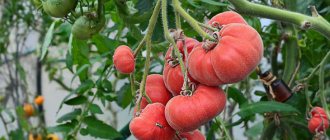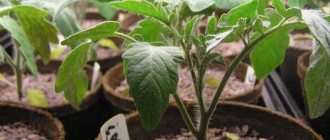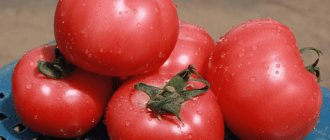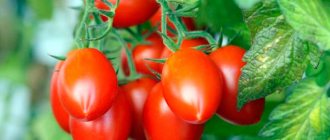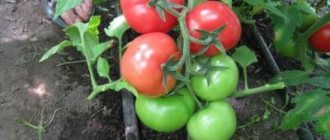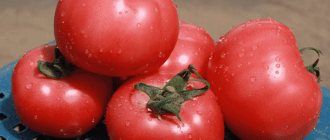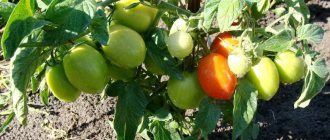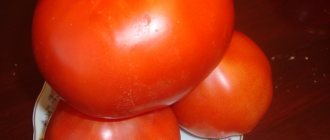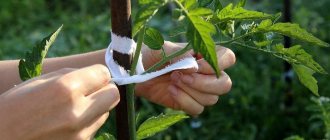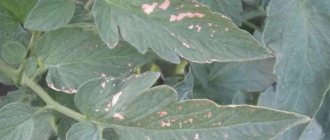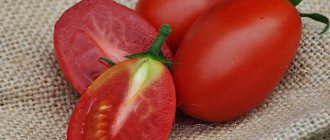Growing tomatoes is not only healthy and tasty, but also fun and exciting. Especially with a find like the Purple Pumpkin. Huge corrugated fruits look luxurious. You can use them to prepare royal salads and create a lot of delicacies for winter.
| Height | Landing location | Ripening time | Fruit color | Fruit size | Origin | Fruit shape |
| Tall | Greenhouse, Open ground | Mid-season | Bicolor | Large | Variety | Flat-round |
Description of the tomato variety Purple Pumpkin, reviews, photos
The original name of the tomato is Purple Calabash .
Mid-season, tall, indeterminate tomato variety. Recommended for growing in greenhouses (in the middle zone) and in open ground in the southern regions with mandatory tying to a support. It is best to form a plant into 2-3 stems. The height of the bush is up to 1.7 meters.
Fruit characteristics
photo author A. Kulik
The fruits are large, flat-round, ribbed, purple in color (closer to purple) at maturity, weighing up to 300 grams. The fruit pulp is juicy, tasty, with a slight sweetness.
The variety is very productive and beautiful.
In some catalogs this variety is found under the name Purple pumpkin , Pink calabash .
Tomato Purple pumpkin: description of the variety and cultivation characteristics
Good afternoon, my reader. Today, purple tomatoes are a phenomenon that will not surprise anyone. But this variety began to be in demand among summer residents not so long ago. It gives a good harvest both in the greenhouse and in open beds. The fruits can have different shades - from light purple to black-violet. To develop such varieties, the nightshade tomato was used, which is considered poisonous, but is resistant to diseases and temperature fluctuations. The most beautiful varieties of unusual colors include the Purple Pumpkin tomato.
Tomato Purple pumpkin (Photo from semenaorg.ru)
The indeterminate variety has an incomplete growth trend, but if all growing conditions are met, the height of the bush can be 1.7-2 m.
Purple pumpkin is an early ripening variety. Tomatoes ripen 105-115 days from the moment the first shoots appear. The fruits are large and ribbed. The weight of one specimen can be 200-350 g. The pulp is juicy, strong, and has a light fruity flavor. The variety is high-yielding. From one bush you can collect 3.5-5.5 kg of fruit.
Purple pumpkin is not suitable for making winter twists. Tomatoes are consumed fresh and used as a base for juices, pastes and sauces of original color.
Purple pumpkin is successfully grown in Russia, Ukraine, and Moldova. But maximum yield can be achieved in central Russia and in regions with a warm climate.
Purple pumpkin is recommended to be grown in open ground. The brightness of the fruit and the level of anthocyanin, which has medicinal properties, directly depend on the illumination of the area.
Purple pumpkin is considered a variety that, when the seeds are collected, passes on all its characteristics to its offspring. The collection of planting material and its further cultivation can be carried out independently.
Seeds are selected from ripened fruits. They are washed under running water and allowed to dry naturally.
Before sowing seeds for seedlings, pots with soil are brought into a warm room, and the seeds are treated with a disinfectant solution and soaked in a growth stimulator. The soil mixture should be purchased ready-made.
Pots with plantings are covered with newspaper or polyethylene and sent to a warm place. The first shoots can be observed within a few days. As soon as they appear, the covering material is removed and the pots are placed in a well-lit place. Next, the seedlings are picked, hardened and planted in the beds in the second or third decade of May.
Throughout the growing season, tomatoes will need appropriate care. The summer resident will need to tie the bushes to supports, shape them, water with warm water, loosen the soil and apply fertilizer.
All varieties of tomatoes in the purple color scheme are characterized by increased resistance to diseases such as late blight, fusarium, and verticillium. If the summer is rainy, they may be affected by rot. To prevent this, it is necessary to pay attention to preventive measures, which involve treating the bushes with copper-based preparations (1-2 times per season).
As for pests, the Purple pumpkin is most often attacked by whiteflies, which actively reproduce and can destroy the crop.
If the fruits are ripe, but have not acquired a purple hue, this indicates that all agrotechnical aspects were not observed during cultivation.
Features of cultivation
Sowing the seeds of this variety of tomatoes for seedlings is carried out 60-65 days before the intended planting in the ground.
If you have grown Purple Pumpkin tomatoes, please write whether you liked them or not. What was the yield and taste of the fruits like under your climatic conditions? Write briefly the advantages and disadvantages of this tomato in your opinion. If possible, attach a photo of the entire bush or individual fruits you grew to your comment. Thank you!
Your reviews of the Purple Pumpkin tomato and additions to the description will help many gardeners evaluate this variety objectively and decide whether it is worth planting or not.
Growing tomatoes is not only healthy and tasty, but also fun and exciting. Especially with a find like the Purple Pumpkin. Huge corrugated fruits look luxurious. You can use them to prepare royal salads and create a lot of delicacies for winter.
Reviews and uses of tomato Purple pumpkin
After growing this variety on their plots, many gardeners complain that their tomatoes never turned purple, but only acquired a pinkish-purple hue. This is explained by the fact that when cultivating tomatoes, agrotechnical techniques were not followed, and the soil was not sufficiently fertilized. In addition to this unpleasant fact, many gardeners were very pleased with the Purple Pumpkin due to its resistance to pathogens, taste and decorative properties.
Purple pumpkin is not at all suitable for canning in its entirety at home, but it produces good juice, paste and sauces, distinguished by an original shade and a pleasant fruity-tomato taste.
Description and characteristics of the variety
The Purple Pumpkin tomato is included in the tall growing indeterminates. Strong and powerful bushes have characteristic features:
- stem height 1.8-2 m;
- semi-spreading branched trunks;
- 3-5 tomatoes in clusters;
- inflorescences are simple.
What is a typical tomato variety description:
- average weight 250-350 g;
- giant fruits weigh up to 500-600 g;
- purple color with purple tints;
- pronounced ribbing at the stalk and on the sides - the fruit resembles a flower;
- the flesh is fleshy, tender, moderately juicy;
- The taste has sweetish notes, there is a fruity aftertaste.
Description of the Purple Pumpkin tomato, its yield, reviews of the variety
Until recently, tomatoes with a purple color were considered an unprecedented miracle, and it was quite a rarity to come across such a curiosity on gardeners’ plots. However, today, thanks to the efforts of the originators, amethyst and black-violet tomatoes are successfully grown both in film shelters and in open ground, and their shade of existing varieties varies from soft lilac to black-violet.
Similar varieties of tomatoes were bred with the participation of a gene from one of the nightshade tomato species, which is quite poisonous in nature, but has increased resistance to diseases and temperature changes. One of these fabulously beautiful varieties is the Purple Pumpkin tomato.
Outlining the tomato variety Purple pumpkin
The variety is indeterminate, having an incomplete growth trend, but when grown seasonally, the plant height reaches 1.7-2 meters. Mid-ripening, they produce their technically mature fruits 105-115 days after the appearance of the first shoots, which reach a weight of 200-350 g and are distinguished by a purple-violet color. The fruits are large, flat-round, with pronounced ribbing.
The bush is heavily leafy with leaves of juicy green color. A cross-section of a tomato shows many seed chambers with juicy pulp, which has an excellent tomato-fruit aftertaste. The yield indicators of purple pumpkin are quite good and the tomato harvest from one bush is about 3.5-5.5 kg.
Features of cultivation of Purple pumpkin
Purple pumpkin tomatoes are successfully cultivated in many regions of the Russian Federation, Moldova and Ukraine, but they are most successful when grown in the middle zone and in areas with a fairly warm climate.
It is most preferable to cultivate them in open ground, since the richness of the color and the content of the plant glycoside anthocyanide in tomatoes, which has a healing effect on the human body, depend on bright sunlight. This element strengthens blood vessels and reduces capillary fragility.
Purple pumpkin is a variety that, when its seeds are harvested, imparts all the parental characteristics to its offspring. Therefore, you can collect the grains of this tomato yourself, planting this tomato wonder on your plots for more than one season. Seeds are selected from ripened fruits, washed thoroughly under running water and dried.
Before sowing tomatoes, which falls in the second or third ten days of March, containers with soil are brought into a warm room. It is advisable to purchase soil mixture for seedlings in specialized stores. Before planting, seeds must be disinfected and stimulated. To do this, the seeds are soaked for 30-40 minutes in a weak solution of potassium manganese at the rate of 0.01 g per 1000 ml. Then the seeds are washed under running water and immersed in any growth stimulator for 10-12 hours. After drying, the grains are ready for planting. The soil in the containers must be moistened, the seeds must be spread at a distance of 1.5 cm by 1.5 cm, buried by the same amount and covered with soil.
Containers with sown tomato seeds are covered with newspaper or polyethylene and placed in a dark, warm place. In a few days, the first seedling loops will begin to peck. After they appear, the covering material is removed, the temperature in the room drops by several degrees, and the containers with seedlings are placed in the most illuminated place. After the tomato seedlings grow 2-3 true pairs of leaves, the young plants dive into separate pots, trying to bury each one as much as possible into the soil, in no case covering the root collar during this action.
When positive night temperatures are established in the second or third decade of May, the seedlings are planted in open ground, having previously been hardened for 7-10 days. In order for the fruits of the Purple Pumpkin to acquire a rich, bright color during the growing season, the soil must be prepared in advance before planting the seedlings by adding to each hole:
- 25 g superphosphate;
- 30 g potassium;
- 20 g nitroammophoska;
- humus;
- 1 glass of ash.
Planting and care
Sowing is carried out at a distance of 2-3 cm between seeds. The grooves are sprinkled with a finely dispersed compound on top.
What conditions need to be created for seedlings:
- Temperature regime at 18-20 degrees.
- Moderate humidity 50% due to balanced irrigation.
- Lighting for 12-14 hours.
- Diving at the 2-leaf stage.
- Author: Maria Sukhorukikh
Rate this article:
- 5
- 4
- 3
- 2
- 1
(0 votes, average: 0 out of 5)
Share with your friends!
Tomato Purple Pumpkin
photo author Mira Tom
Description of the tomato variety Purple Pumpkin, reviews, photos
The original name of the tomato is Purple Calabash .
Mid-season, tall, indeterminate tomato variety. Recommended for growing in greenhouses (in the middle zone) and in open ground in the southern regions with mandatory tying to a support. It is best to form a plant into 2-3 stems. The height of the bush is up to 1.7 meters.
Fruit characteristics
photo author A. Kulik
The fruits are large, flat-round, ribbed, purple in color (closer to purple) at maturity, weighing up to 300 grams. The fruit pulp is juicy, tasty, with a slight sweetness.
The variety is very productive and beautiful.
In some catalogs this variety is found under the name Purple pumpkin , Pink calabash .
Features of cultivation
Sowing the seeds of this variety of tomatoes for seedlings is carried out 60-65 days before the intended planting in the ground.
If you have grown Purple Pumpkin tomatoes, please write whether you liked them or not. What was the yield and taste of the fruits like under your climatic conditions? Write briefly the advantages and disadvantages of this tomato in your opinion. If possible, attach a photo of the entire bush or individual fruits you grew to your comment. Thank you!
Your reviews of the Purple Pumpkin tomato and additions to the description will help many gardeners evaluate this variety objectively and decide whether it is worth planting or not.
A storehouse of vitamins in one fruit - the Purple pumpkin tomato: description of the variety, reviews of yield
Growing tomatoes is not only healthy and tasty, but also fun and exciting. Especially with a find like the Purple Pumpkin. Huge corrugated fruits look luxurious. You can use them to prepare royal salads and create a lot of delicacies for winter.
| Height | Landing location | Ripening time | Fruit color | Fruit size | Origin | Fruit shape |
| Tall | Greenhouse, Open ground | Mid-season | Bicolor | Large | Variety | Flat-round |
Description and characteristics of the variety
The Purple Pumpkin tomato is included in the tall growing indeterminates. Strong and powerful bushes have characteristic features:
- stem height 1.8-2 m;
- semi-spreading branched trunks;
- 3-5 tomatoes in clusters;
- inflorescences are simple.
What is a typical tomato variety description:
- average weight 250-350 g;
- giant fruits weigh up to 500-600 g;
- purple color with purple tints;
- pronounced ribbing at the stalk and on the sides - the fruit resembles a flower;
- the flesh is fleshy, tender, moderately juicy;
- The taste has sweetish notes, there is a fruity aftertaste.
Advantages and disadvantages
- large fruit;
- useful composition;
- excellent product characteristics;
- wonderful taste;
- easy cultivation;
- disease resistance;
- endurance of adverse weather.
Of the minuses:
- the importance of fertilizing;
- need for fixation.
Productivity
4 kg of fruits ripen on 1 bush.
Features of cultivation and storage
The beds are arranged in a sunny, well-fertilized area.
Effective nuances of care:
- Fertilizer application during flowering and ripening.
- Watering 2 times a week, the norm per bush, depending on dryness, is from 8 to 10 liters.
- Leading in 2 escapes.
Planting and care
Sowing is carried out at a distance of 2-3 cm between seeds. The grooves are sprinkled with a finely dispersed compound on top.
What conditions need to be created for seedlings:
- Temperature regime at 18-20 degrees.
- Moderate humidity 50% due to balanced irrigation.
- Lighting for 12-14 hours.
- Diving at the 2-leaf stage.
